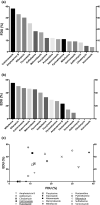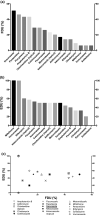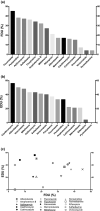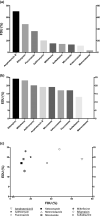Drugs used for the treatment of cerebral and disseminated infections caused by free-living amoebae
- PMID: 33650319
- PMCID: PMC8212752
- DOI: 10.1111/cts.12955
Drugs used for the treatment of cerebral and disseminated infections caused by free-living amoebae
Abstract
Free-living amoebae (FLAs) are protozoa developing autonomously in diverse natural or artificial environments. The FLAs Acanthamoeba spp., Balamuthia mandrillaris, and Naegleria fowleri represent a risk for human health as they can become pathogenic and cause severe cerebral infections, named granulomatous amoebic encephalitis (GAE), Balamuthia amoebic encephalitis (BAE), and primary amoebic meningoencephalitis (PAM), respectively. Additionally, Acanthamoeba sp. can also rarely disseminate to diverse organs, such as the skin, sinuses, or bones, and cause extracerebral disseminated acanthamebiasis (EDA). No consensus treatment has been established for cerebral FLA infections or EDA. The therapy of cerebral and disseminated FLA infections often empirically associates a large diversity of drugs, all exhibiting a high toxicity. Nevertheless, these pathologies lead to a high mortality, above 90% of the cases, even in the presence of a treatment. In the present work, a total of 474 clinical cases of FLA infections gathered from the literature allowed to determine the frequency of usage, as well as the efficacy of the main drugs and drug combinations used in the treatment of these pathologies. The efficacy of drug usage was determined based on the survival rate after drug administration. The most efficient drugs, drug combinations, and their mechanism of action were discussed in regard to the present recommendations for the treatment of GAE, EDA, BAE, and PAM. At the end, this review aims to provide a useful tool for physicians in their choice to optimize the treatment of FLA infections.
© 2021 The Authors. Clinical and Translational Science published by Wiley Periodicals LLC on behalf of the American Society for Clinical Pharmacology and Therapeutics.
Conflict of interest statement
The authors declared no competing interests for this work.
Figures





References
-
- Glaser CA, Gilliam S, Schnurr D, et al. In search of encephalitis etiologies: diagnostic challenges in the California Encephalitis Project, 1998–2000. Clin Infect Dis. 2003;36:731‐742. - PubMed
Publication types
MeSH terms
Substances
LinkOut - more resources
Full Text Sources
Other Literature Sources
Miscellaneous

